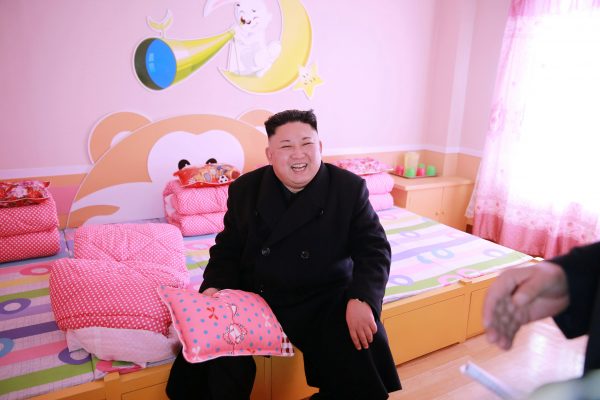On 12 February, with Kim present at the test site, North Korea successfully launched a Pukku’kso’ng-2 intermediate range ballistic missile, which it described as ‘a new strategic weapon of our own style’. The launching of a solid-fuel missile from a track-wheeled vehicle was not the widely anticipated test of an intercontinental ballistic missile that North Korea claims it could undertake at a moment’s notice. But it attested to important advances in North Korea’s ballistic missile capabilities and to Kim’s continued ability to ignore near-universal opposition to his weapons programs.
The test of a mobile missile — a land-based version of a sea-launched missile first successfully tested in August 2016 — has a postulated ability to reach targets anywhere in South Korea or Japan. It is a more survivable weapons system capable of much more rapid firing than the liquid-fuelled predecessors that have long dominated North Korea’s missile inventory. North Korea claims the new missile is capable of carrying a nuclear warhead, though this claim remains unproven.
Two days after the missile launch, North Korean agents operating in Malaysia undertook a highly brazen terrorist action, assassinating Kim Jong-nam, Kim Jong-un’s half-brother, in a terminal at the Kuala Lumpur International Airport. The now deceased elder sibling is the latest victim in a string of executions undertaken at the behest of Kim Jong-un since he assumed power in late 2011, including the December 2013 execution of Jang Song-thaek, an uncle by marriage to the two Kim brothers.
The total number of executions (including numerous senior officials) undertaken on Kim’s orders now exceeds 300. But Kim Jong-nam’s assassination was the first one outside of North Korea in recent years, even though there is ample history of North Korean terrorist actions over the decades. One such example is the Rangoon bombing of 1983, which killed 17 senior South Korean officials and cabinet members, deeply agitating Deng Xiaoping and other Chinese leaders of the time. The latest assassination highlights the single mindedness of the agents acting at North Korea’s behest and the major shortcomings in Malaysia’s airport security.
Kim Jong-nam had long been alienated from his younger half-brother, and had voiced open scepticism about dynastic succession in North Korea. According to South Korea’s National Intelligence Service, Kim Jong-nam has long been a marked man. He purportedly sent a letter to Kim Jong-un in 2012 beseeching him to spare his life, but to no avail.
The younger Kim’s continued elimination of his political opponents underscores his taste for blood and represents a clear warning to others within the North Korean elite. It resonates with the 1930s exchange between the British parliamentarian Lady Astor and Joseph Stalin. Lady Astor asked Stalin when he would stop killing fellow citizens; his mordant response remains chilling decades later: ‘When it is no longer necessary’.
Kim Jong-un has joined a long, disreputable lineage of leaders prepared to employ murder as a political tool. But he is also steadily amassing the means to threaten countries he deems to be the enemies of North Korea, which may ultimately include the capacity to reach the United States.
The missile test and the murder in Kuala Lumpur might seem like very different actions, but both involve means to a common goal. Kim views the threat or use of violence as essential to his own survival and to the survival of the regime. In this regard, other members of the North Korean elite have ample reason to fear him. Neighbouring states within the reach of North Korean missiles must also redouble efforts to minimise Kim’s threats to international security.
The near simultaneous events of the past week yet again pose the question of how to counter Pyongyang’s open assault on international norms. Unless China is prepared to make North Korea pay a price for its latest actions, the prospect for tougher measures under UN Security Council auspices seem remote.
But North Korea’s renewed resort to terrorist activity on a Southeast Asian state demands a coordinated regional response. At a minimum the ASEAN member states — some of which have sought engagement with North Korea — should severely limit Pyongyang’s activities in the region, including its search for new economic partners. Kim will conclude that his actions are punishment free unless meaningful penalties are imposed on North Korea. This is a dangerous conclusion which would only weaken the basis for the concerted response that his flagrant actions undoubtedly warrant.
Jonathan D. Pollack is the Interim SK-Korea Foundation Chair in Korea Studies at the Center for East Asia Policy Studies and a senior fellow in the John L. Thornton China Center at the Brookings Institution.
This article was first published here by the Brookings Institution.


As many people know, the Chinese characters for the word ‘crisis’ are ‘danger’ and ‘opportunity.’ Kim jung Un’s recent defiant behavior offers other countries an opening to do something about it.
Perhaps the Chinese stopping coal imports from the DPRK means they realize it is time to harden their stance vis a vis Kim. We shall see if Xi and his cohorts sustain this pressure. Will the ASEAN countries who engage with the DPRK also take some steps?